How We Spend Our Lives
Or: a peek into a journaling practice that actually works for me and how you can try it too if you want!
“How we spend our days is, of course, how we spend our lives. What we do with this hour, and that one, is what we are doing.” — Annie Dillard

Tucked in a corner behind my bedroom door, I have a wicker basket full of journals. The basket was the best solution I had to store them — always hidden but close by. I let go of a lot of stuff before moving from Florida to Massachusetts, but somehow these made the journey to my new home along with my vinyl collection and selected books (and ya know, necessities like clothes).
The journals were mostly gifts, all shapes and sizes. There’s a Winnie the Pooh book with some of my earliest and cringiest poetry, a pastel spiral notebook where I scribbled show prep notes in my radio days, and multiple pretty floral journals that look way more cheerful than whatever twenty-something angst I was working out inside. Once a year or so, I’ll pick one out at random, flip through it, and try to have compassion for the girl who wrote those words. As Madeleine L’Engle wrote, “I am still every age that I have been," and here is a basket of tangible confirmation that Past Jen existed and exists still.
But capital-J Journaling, at least in that longform, late-night, brain-dump way, has always been a haphazard project. If I took the time to organize them, I know I would find massive time gaps. I tended to take up Journaling whenever I went through a major transition, like going to college, launching a career, spiritually deconstructing when nobody called it that, or trying to figure out if my nice Internet friend could be more than a friend.1 But a record of the mundane things that make a life? That’s called a diary, and I stopped doing that when I was, like, eight.2
I do think reflection on paper is a helpful way to not let your life fly by, especially when so much evidence of the past lives on the Internet, one social media platform collapse away from erasure.3 A couple years ago, I finally found out a method that works for me. If you’re looking for an analog practice to try out this year, here’s what I’ve been doing.
Getting Started
Back in 2021, I picked up a copy of The Next Right Thing Guided Journal by Emily P. Freeman. I don’t typically go for guided journals. They can feel a little too restrictive for me. But I knew her contemplative approach could be a good fit for me, so I thought I’d give it a go.
Sure enough, I wrote in it for two weeks and forgot about it.
By December 2022, I’d figured out my dedicated physical space for morning reading/reflection, and decided to give it another shot. I put the journal near my morning corner. As it turns out, physical proximity was the key to sticking with it! I liked the rhythmic approach of quarterly, monthly, and weekly pages. I liked how the These Are the Days pages encourage you to record the shape of your weeks rather than every last detail, and I liked the once a month section for personal examen — What was life giving? And what was life draining?
There were some elements I didn’t really use or find quite as helpful, but I stuck with the quarterly and monthly pages for a whole year! When another December4 came around, I decided to DIY my own version using one of my many unused blank journals.
I’m now starting my second year with this model, and so far it’s still working. If you are looking for something ready made, I highly highly recommend ordering a copy of The Next Right Thing Guided Journal (not sponsored, I just love it). But if you want a more custom approach, here’s what I do… take what you need and leave the rest.
The Monthly Pages
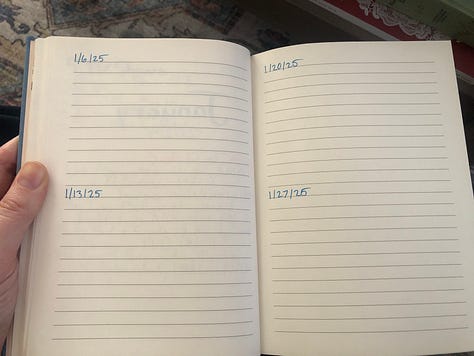
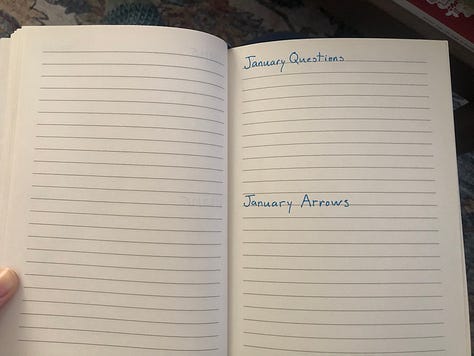
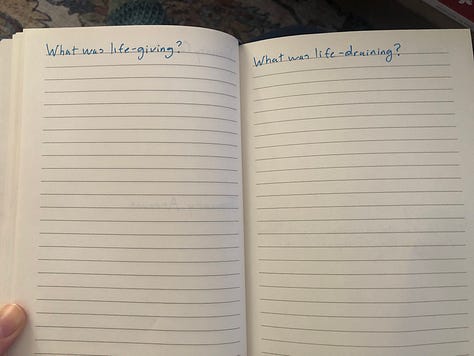
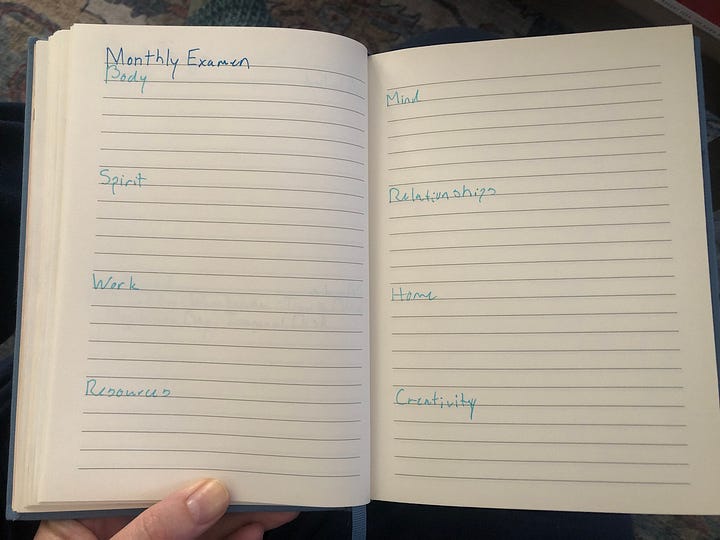
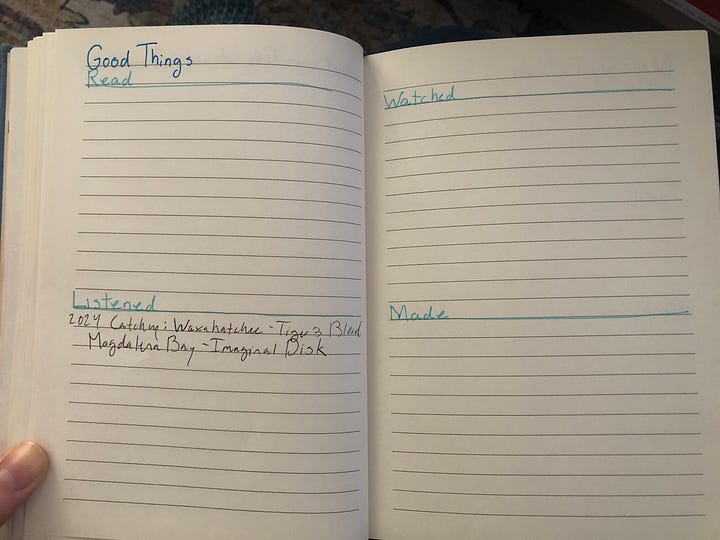
At the start of a new month, I create a title page (sometimes just the month name, sometimes a little fancier with stickers and stuff because I’m a little craft supply goblin). Then I set up the following sections:
Weekly Logbook5: Adapted from the These Are the Days pages in TNRT, this is just a half page per week for jotting down the shape of the week. I write the date for each Monday across two pages (add another page if the month has 5 Mondays). Throughout the week, I’ll write down one or two events of the day. Occasionally there’s a big event. Most days, it’s something like “working and walking Malika.” Noting the weather or a general mood is acceptable too. This is a reminder to me that even when life plods along in routine, those moments make the rhythm of a life.
Questions and Arrows: Another page split in half, and exactly what it sounds like. On the first half, I write down some questions I’m bringing into the month — decisions to make, personal wrestlings. Throughout the month, if any sort of clarity, direction, or hint toward an answer arises, I’ll write that down as an arrow. (This is also from TNRT, and here’s a podcast about looking for arrows.)
Life Giving/Life Draining: A classic examen approach. Throughout the month, I’ll make a bullet point list of things that filled me and things that drained me. This is a good way to keep tabs on things you may want to do more or less of. It’s especially great for folks like me that can float through life without noticing what I want or need.
Monthly Life Examen: For a few years, I used Sacred Ordinary Days planners, and I really liked their examen format, even though I couldn’t keep up with doing it weekly. Monthly is about the perfect timing for me, so I include it here! I split the page up into 8 categories: Body, Mind, Spirit, Work, Relationships, Home, Resources, and Creativity. (the last one is my addition) At the end of the month, I’ll reflect on each of these areas and ask the life giving/life draining question. Then I write a sentence or two about how I’m doing. The key to this one is to be non-judgmental, because I’m not sure anyone can thrive in all 8 categories all the time. But this is helpful for noticing patterns and areas that might want a little extra attention.
Lately I’ve been testing out adding a little “Life Pie” in the corner, an Artist’s Way exercise that creates a graph of how the different parts of life are weighted. It feels a little extra, but might help if you like a visual. (You can read more about this exercise here.)
Good Things: TNRT calls this the Happy List. This space is for writing down what I watched, listened to, read, and made that month. No reviews or judgement. Just lists. Pretty self-explanatory. You could probably add other categories if you want.
And there you have it! As you can see, my spreads are not fancy. Right now, I’m working in a lovely thick hardcover journal that I got for my birthday. I also have a cheap composition book for morning pages / when I really need to brain dump, but this works great for a regular practice. I’m finding that passing time feels just a little less rushed, and I can actually remember key moments and get a sense of my seasonal rhythms.
If you’re looking for a reflection practice and want to give this a try, feel free! Take the interesting pieces, skip the ones that don’t work for you, remix and make it your own. Maybe it will work, or maybe it won’t, but I hope it’s at least interesting. And if you already have a process you use to reflect and record your life, I’d love to hear what’s working for you.
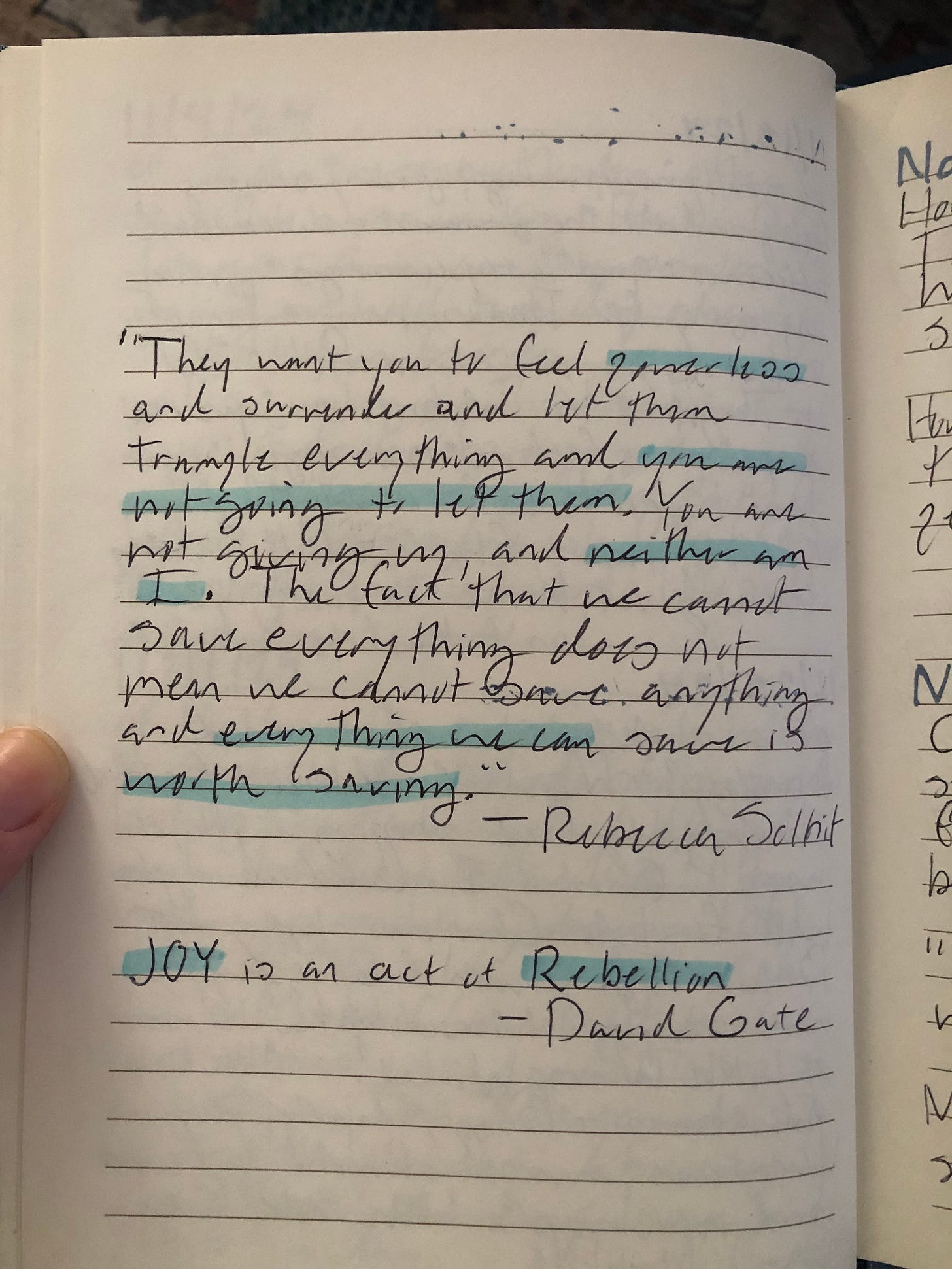
Spoiler alert: he was.
Remember those diaries with a lock to protect the HIGHLY SENSITIVE SECRETS of an 8 year old? I definitely had one.
Pretty sure my journaling practice went off a cliff after I got into blogging and social media. RIP my old LiveJournal and Twitter.
This journal is structured around physical seasons, so my year runs December to November (winter to fall).
I like calling it a logbook a la Austin Kleon, though my logs aren’t quite as thorough as his approach.





thank you for sharing! I don't know if I can handle this much introspection, but it's good to have goals, and I like seeing how others journal.
When I need to brain dump, I pick up whatever is near and write in it. Sometimes that's my laptop, sometimes it's a journal. I have like 3 or 4 going at once and am not linear at all by sticking with just one. I name my virtual journal entries weirdly and randomly, like Rebel Yell or Practice Makes Perfect. In the physical journal I just write the date at the top.
But I like your choices here, perhaps I'll consider applying some of them. It's fun to see your approach and hear about what it's done for you. (Also I've yet to read Emily's book, or do a daily examen practice. Perhaps they're in my future though!)